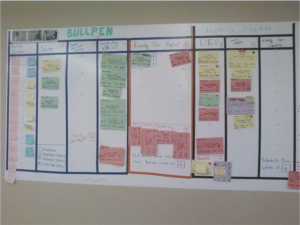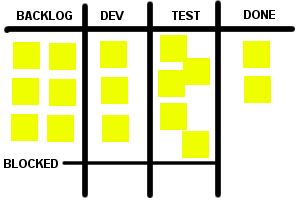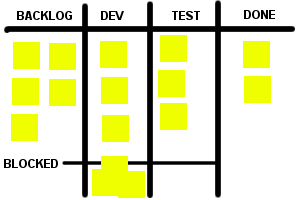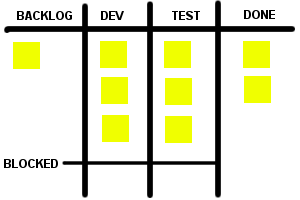Getting the most out of your Agile card wall
One thing that you’ll find on pretty much every Agile project is some kind of card wall where features are tracked.

When I started working on Agile projects several years ago, I didn’t quite understand the purpose of the card wall. I thought, wouldn’t you rather just track everything in some online tool?
While tracking things in an online tool is still a good idea, the Agile card wall gives you a level of transparency that it’s difficult to get from an online tool. With a good card wall, you can easily see what everyone is working on, what still needs to be worked on, how long the remaining work might take, and what’s blocking your progress. There is so much to keep track of on a software project, and it really helps when you have a visual aid that can help keep everything in front of you so that you don’t have to juggle everything in your mind (or some online tool).
The trick is to tweak your card wall to give you the most transparency as possible. Here are some things that I’ve found help me get the most of my card wall.
Everything is a task
Everyone puts development tasks on their card wall. However, not everything that your team does could be categorized as a deliverable feature. In fact, there are lots of other things that you might have to do:
- Write up documentation on a wiki
- Onboard a new team member
- Set up a CI build
- Get ready for a demo
These are all tasks that are completed by development team members that take a measurable amount of time. So why not create a card and put them on the board? Maybe you use a different color card to indicate that it’s an internal task. This gives you two benefits — you know what people are working on and you can use the estimate to gauge how much work is left to be done.
Make card walls for your entire team
If our development card wall can help us track what developers are working on and how much work is left, why not create card walls for the entire team? You could have a card wall for BA requirements gathering, QA creating test plans, project management tasks, or some mini-project that you want to track separately. You get the same benefits that you get with a development card wall — you know what people are working on, you can easily see the status of the effort, you can prioritize the backlog, and it can help you get an idea of how much work is remaining.
Make problems obvious
Your card wall should alert you to any problems and blockers as soon as possible. As a team lead, your job is to try and remove any blockers and constraints that could keep your team from being able to do their job. Some ways that you can do this:
- Create a separate section of your card wall for blocked items
- If something is blocking a feature, put a post-it note on the card and write what the blocker is
- Structure your card wall so that you can see problems immediately just by glancing at it
Let’s look at some examples of some simple card walls and we’ll interpret what we see.
Example #1

In this example, we can easily see that we are either developing things faster than we can test them, or things are getting stuck in testing due to bugs. We may need to assign more people to testing or work on reducing bugs.
Example #2

There are a lot of features that are blocked. We should try and address the blocking issues and look and see if there is some greater problem that is causing things to get blocked. Maybe we need to write better features, or maybe we need to get more time from people in the business who can answer questions.
Example #3

We don’t have much in our backlog, so the developers are going to be out of stuff to do really soon. We may need to get more people working on requirements gathering.
Example #4

Things are flowing pretty smoothly. We have a good sized backlog, no blockers, the work is evenly distributed, and we’re getting a lot done.
The key is that we want to see problems as soon as possible so that we can take the necessary steps to correct the problem and keep things moving.
Address technical debt as part of the process
As much as we hate to say it, sometimes we are forced to shove in lower quality, untested code in order to meet a deadline. I don’t like having to do this at all because of the risks, but when this happens, keep track of all technical debt that will need to be fixed and create separate cards for fixing it. Make these cards a different color so that they stick out. Then use your board to explain to your manager or project sponsor that you’re going to need some time to go back and fix the technical debt. Many managers want to pretend that the work is done once you release and will convince themselves that they can just move on without addressing the technical debt. You know better, and it’s your job to state that case and show why it’s important.
Refactor your card wall
Your card wall is yours. You create it, you manage it, and it belongs to you. Don’t be afraid to rearrange and refactor your card wall so that it can better meet your needs. Don’t make excuses like “we’ve always done it this way” or “we read a book that said to do it this way” or things like that. Your process and tools need to serve you not the other way around.


You forgot example four where there are no items in the back log and no items in dev. All the developers are idle because the business can’t decide what they want.
Well done, Jon. Though I think the word “kanban” should appear in the post somewhere. :)
I’m not a big fan of blocked columns. I’ve used them in the past in some situations, but by default they tend to fill up. Devs by nature want to “just write code” and usually on the code they can get done. If something can hold them up or cause a question, no matter how small, if there’s a blocked column they’ll chuck it in there. Obviously the issue there isn’t so much with the wall as it is with the team rules, but IMO the blocked column is enabling the mindset of “somebody else will get it.”
Instead, I like the “fix it now” approach, or specifically the “stop the line” mentality from lean. If it’s blocked and it was important enough to the business be prioritized so it’s in progress now, then get it unblocked as soon as you can. If you, the dev/dev lead/grand pooh-bah can’t get it fixed, get it into the hands of the person who can fix it.
Tim,
I think it depends what your environment is like (regarding the blocked column). In some places things can’t be resolved quickly (the right people might not be readily available, or maybe a meeting needs to occur). I don’t think that developers should stop working just because of that, which is one of the beefs I have with kanban. If you can get blockers resolved quickly, then that’s awesome, but it seems that it usually takes a little longer than that.
I depends on a lot. Environment, team maturity, situation, product, etc – I don’t disagree. So matching your situation is obviously bigger than what columns you use or not.
But, “stop the line” doesn’t mean you stop working to get the item done, you just might not be coding while you get it unblocked. If it’s a big block that takes time, you’ve added some more transparency to your system: How’d we let that item get to work in progress if the block was that big?
Great posting, it sums up kanban pretty well I think. I particularly like the part about using low-tech tools, which I think, many teams could benefit from. I wrote about it here: http://blog.workingsoftware.se/2011/01/power-of-low-tech.html